Another close-up photo for you to analyze and identify:
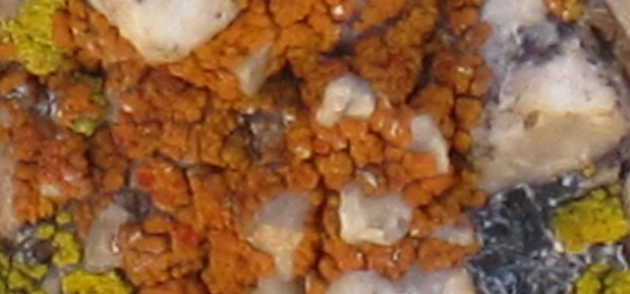
A more inclusive photo on Monday will solve the mystery. (Sorry for the brevity – I’m on the road and internet access is variable. I’m taking what I can get!)
Enjoy your spring weekend!
This past weekend I had the opportunity to speak at Epcot Center in Florida. It was, without a doubt, one of the highlights of my career so far. I spoke 6 times over the course of 3 days. The focus of my talk was garden remedies. I started by talking about Paris Green (a good story for next week), then made fun of some of Jerry Baker’s, Myles Bader’s and Joey Green’s recommendations, and then proceeded to talk about which homemade cures do and don’t work and why. And then I asked the audience for questions. I always ask the audience for questions at the end of my talks, but I’ve never had such a diverse audience before (both gardeners and non-gardeners from all across the country), so it was interesting to see which problems came up the most. The winner was…. Japanese beetle with fire ants and deer coming in a close second and third. With that in mind I thought I’d devote this column to Japanese beetle control.

Above is my newest prize possession — A statue of Mickey thanking me for speaking at Epcot
The first rule of Japanese beetle control is that you can’t control Japanese beetles. Nobody has found a sure-fire cure yet and, if you try too hard, you’re going to poison yourself and everyone in your neighborhood.
The second rule of Japanese beetle control is like unto the first. Don’t trust garden center employees to know a damn thing about Japanese beetle control.
The third rule of Japanese beetle control is not to make the problem worse that it already is. Using a trap to lure Japanese beetles to their demise will kill a few — and may make you feel like you’re doing something — but you will be attracting more beetles to your yard than you kill.
The fourth rule of Japanese beetle control is that killing grubs doesn’t stop the adults. In other words, while killing Japanese beetle grubs is possible (usually using imidacloprid), killing those grubs won’t prevent adults from flying into your yard after they’ve hatched from someone else’s yard.
The fifth rule of Japanese beetle control is that Japanese beetle control is dirty work. Most of the “organic” and biological controls just don’t work that well. If you want to spray a concentrated dish soap spray on the beetles that will kill them, but it won’t last long and it will burn your plants. Same thing with a spray of one of those citrus insecticides. The organic insecticide pyrethrum will kill Japanese beetles, but it won’t last long and spinosad (another organic insecticide) which works for some beetles (it’s better on other insects) just isn’t considered that great. A biological control called Milky Spore Disease is supposed to kill Japanese beetles while they’re grubs, but the truth is that it usually kills less than 50% even in good conditions.
The sixth rule of Japanese beetle control is that, if you’re willing to go to a little bit of trouble, lose a few leaves, and use a little bit of a synthetic insecticide there is a way to protect your plants to some degree. If you’ve ever been around these beetles then you’ll know that they prefer some plants over other — for example, they love roses, and so they’ll attack roses first. If you spray roses with permethrin (a synthetic insecticide) you can get 7-14 days of clean roses, and, if you’re lucky, you’ll kill many of the Japanese beetles before they move on to other plants — this is called trap cropping.
The seventh rule of Japanese beetle control is that these beetles will seek revenge for their dead relatives.
I’m spending this week in Palm Desert, CA for a little R&R in the sun. In the morning, with my pot o’ Earl Grey, I read the local paper (The Desert Sun). Last Sunday’s paper provided me with an article about an “intelligent water incubator” (all material in quotes was taken from the article). Pieter Hoff, a “Dutch scientist, author, and major exporter of lilies and flower bulbs” has invented the Waterboxx, which “produces and captures water from the air through condensation and rain.” He claims a four year test in the Moroccan Saharan desert showed an 88% survival rate for fruit tree saplings “grown without irrigation.” He now wants to test his invention in the Coachella Valley desert “to create a money-making business model with trees” and of course to help save the environment.
The Waterboxx is a plastic rectangular box, but we’re told the inner technology is more complex. The box is put around the seed or sapling and provides water “in small doses.” It also “protects roots against sun, wind, weeds, rodents and some animals.”

I visited the web page and you should too. The technology section is fascinating. It includes an animation explaining how the box functions; apparently the box was designed to protect seeds in the same manner as bird poop. I was interested to see that the box requires 4 gallons of water when it’s set up; not exactly a “no irrigation” methodology. And that a wick inside the box releases about 50 ml of water a day to the soil below the box. The last frame tells us “with the waterboxx we can transform most of the deserts into forests.”
I won’t test your patience by dissecting all the silliness in this article and the web site. As you might expect, there is no peer-reviewed science on this product, nor even a research report. The plant and soil science is marginal; the ecological science is horrific. The box effectively prevents water from reaching the soil around the seedling, doling it out in miniscule doses instead. Not only could a decent organic mulch layer do the same job (and do it better), but I question the “greenness” of creating yet another plastic product with a limited lifespan. This system is so removed from reality that it’s incredible that anyone takes it seriously – yet it’s been out there for several years now and has won several awards.
Oddly, there’s little specific information about the inventor. All I could find definitively is that he comes from a bulb-raising family in The Netherlands and has written a book: CO2 – a gift from heaven (under the name Petrus Hoff).
It is daffodil season in the Northern Hemisphere, hurrah! May their blooms shoo away the gray of winter! It is also the season where everybody and their mother writes something about the wonders of the genus Narcissus, so figured I’d join the fray, but with a bit of a chip on my shoulder…

Miss ‘Barrett Browning’ in the Hahn Horticulture Garden at Virginia Tech
I recently read YET ANOTHER article warning against mixing daffodil stems in with other cut flowers due to “harmful effects from the sap”. If stems are conditioned, that is, placed in warm water on their own for 12 to 24 hours, it’s supposed to be o.k. This is repeated in everything from floral arranging manuals to gardening articles, but they never say what exactly causes the problem. So I’ve combed through many resources, to find a specific study backing this up and identifying what compound is responsible.
Known:
1) There is such a thing as “daffodil picker’s rash” which has been reported in the journal of Contact Dermatitis (Julian and Bowers, 1997). The authors attribute this rash to the “crystals of calcium oxalate in the sap, in conjunction with alkaloids, [which] act as an irritant, and also cause the characteristic sores.” Duly noted.
2) Said calcium oxalate crystals are found throughout the daffodil, in the bulb, stem, sap, flowers, etc. Micrographs show that these crystals are needle-sharp, and apparently very painful (I have not gotten up the nerve to give them a nom). This is why deer and bunnies will not eat your daffs.
3) The list of alkaloids is fairly extensive (as with many other members of the Amaryllidaceae family), including masonin, homolycorine, and a real nasty one, narciclasine- which disrupts cell division (meiosis) much like colchicine.
4) Are daffodils poisonous? Yes. If you (or your cat) hunkered down and consumed an entire bulb, problems would ensue. But the calcium oxalate crystals are, perhaps, nature’s way of convincing you (or Mr. Twinkles) that this is not a good idea.
So is there really an effect and if so, what makes daffodil sap deleterious to the other flowers in the vase? The study “Effects of Daffodil Flowers on the Water Relations and Vase Life of Roses and Tulips” by W.G. van Doorn appeared in the Journal of Horticulture Science. Dr.van Doorn found the mucilage (sap) was indeed to blame, with just one daff shortening the vase life of both the tulips and roses by almost half. But what component?
He split out the alkaloid fraction and the sugar fraction of the sap, and then added them as individual components to the vase water. He drew different conclusions as to the cause: the research indicated that the effect in roses is mainly due to the sugar and polysaccharide fraction of the mucilage stimulating bacterial growth. This clogged the rose’s vascular system resulting in bent neck. You’ve seen this before – the bud, yet to open, flops over, never to recover.
These same sugars didn’t impact the tulips negatively but the alkaloids sure did. Even touching the sap to the tulip foliage produced a yellow spot. He was not able to distinguish which of the six alkaloids detected were responsible, but at least narrowed down the cause ( sounds like a job for a grad student!).
So there you have it. I feel better. Am off to pick a few daffodils (very carefully) to brighten my office.
Recently, Rebecca Finneran, an MSU Extension Educator from the Grand Rapids area sent me a cool photo. The tree is a large Norway spruce near the Kent country Extension office.

This is a great example of witch’s broom. Witch’s brooms are growth anomalies that occur on various trees, most commonly conifers, Brooms can be caused be a variety of factors including diseases, aphids, environmental stress and random mutations. In some cases the growth defect is only present when the casual agent, say, a pathogen is present. In others, however, the growth mutation can be propagated by grafting scion wood from the witch’s broom onto a regular rootstock. In fact, this is the origin of many forms of dwarf and unusual ornamental conifers. Because of this, brooms are often a prized commodity and ‘Broom hunting’ is an active past-time for conifer enthusiasts such as members of the American Conifer Society. ACS members that find their first brooms are sometimes referred to as ‘Baby broomers’. Broom hunters are a focused lot and have been known to screech to a halt on major interstate in their relentless pursuit of conifer conversation pieces. So keep an eye out for brooms – and broom hunters!
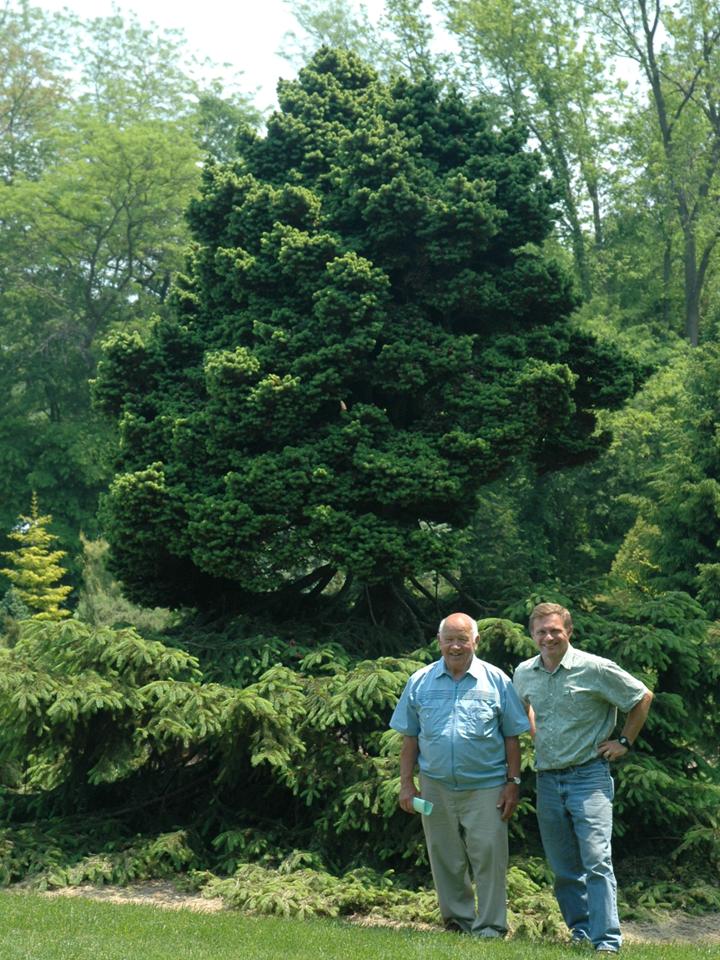
With the late Chub Harper and the ‘Merrill broom’ tree at Hidden Lake Gardens, Tipton, MI
So many interesting answers to Friday’s puzzle – thanks to all of you for putting out the effort! It most certainly is an abiotic problem – but was it temperature, suggested by Deb? Water, suggested by Foy, Gayle and Ed? Light, suggested by Nancy? My plan was to have an extensive soil test run to address the possibility of pollution (suggested by Jim, Heather and Paul), except we discovered the source of the problem last summer when we finished digging our pond:
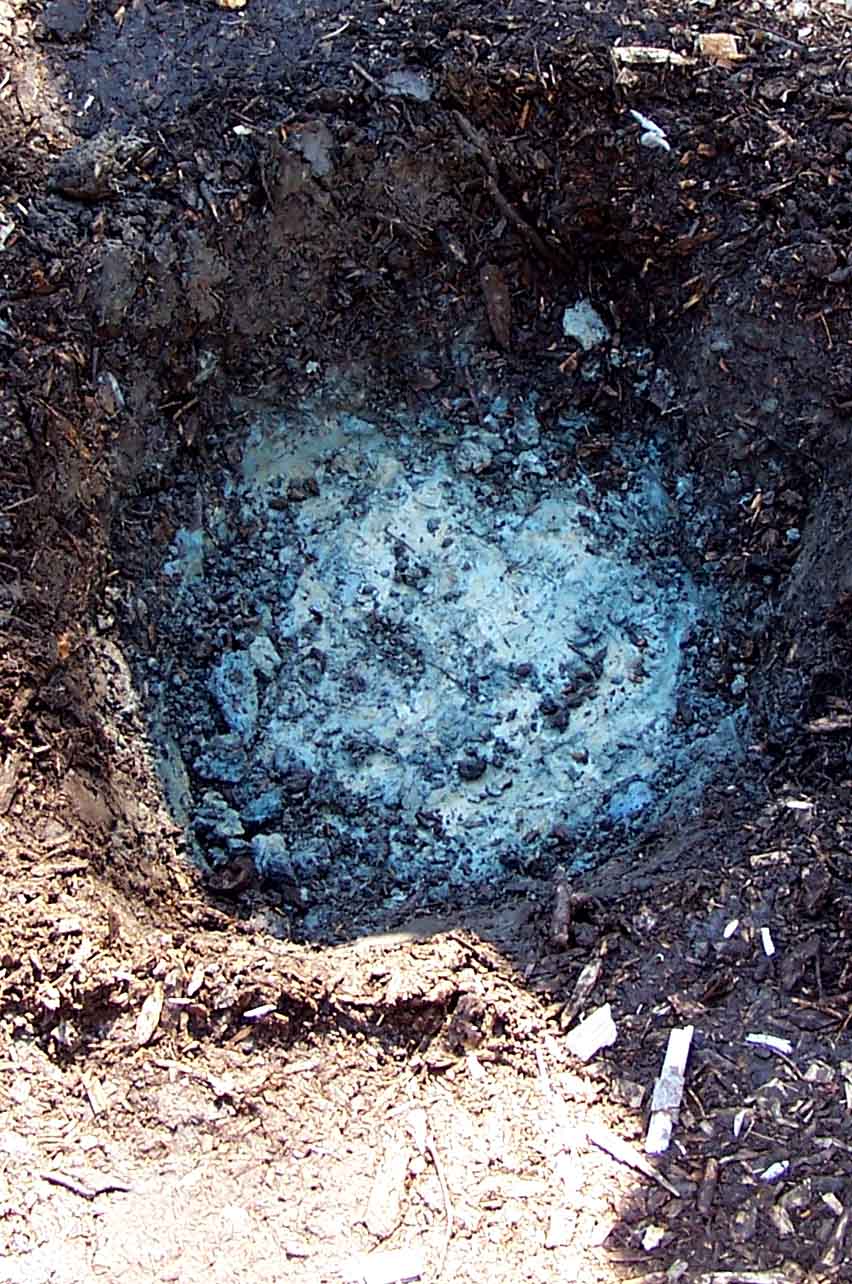
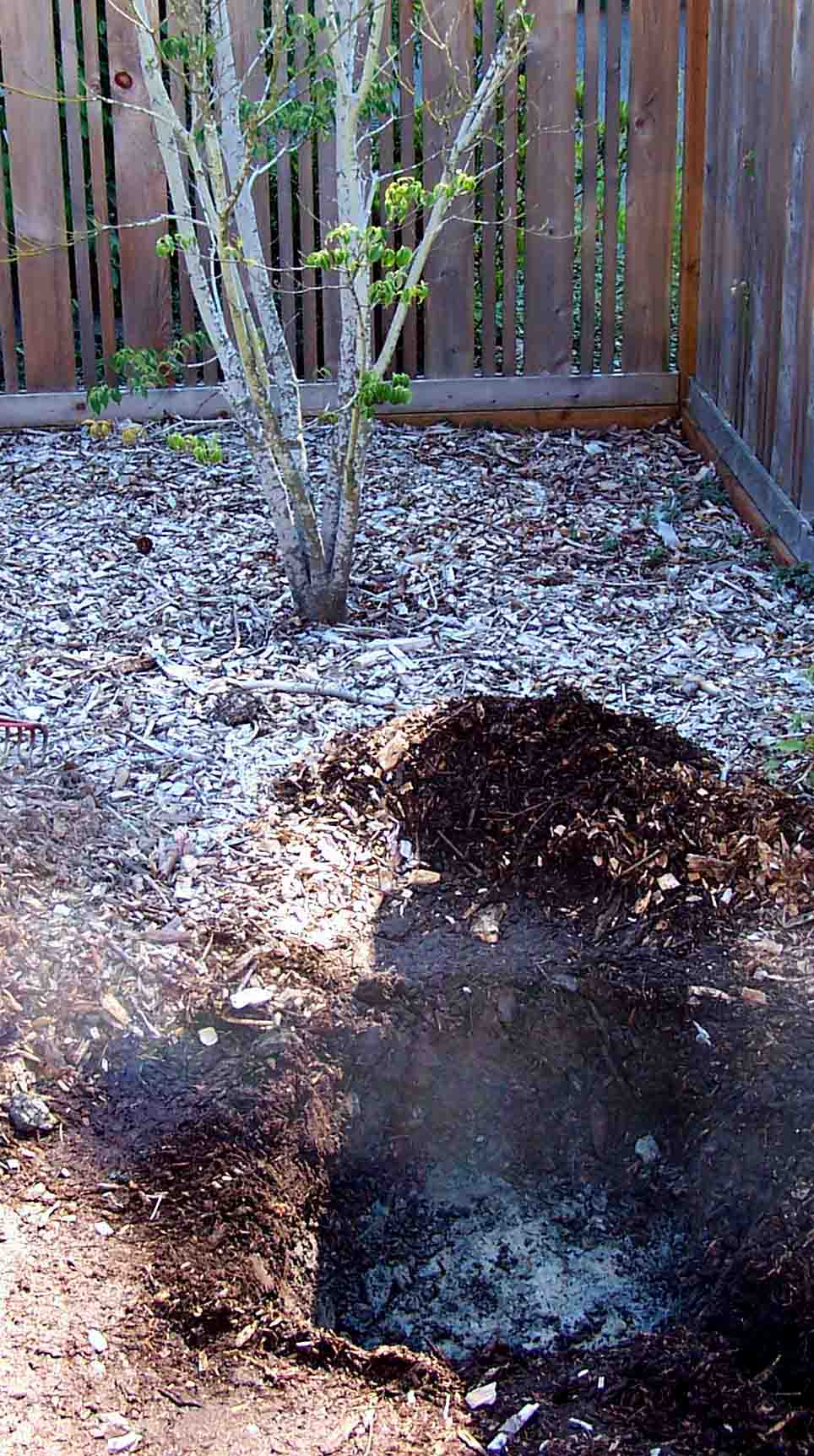
As you can see in this photo, we have solid clay about 12″ below the surface. (And I do mean solid. I’ve kept lumps of the stuff to take to seminars, so when people say “I have clay soil” I pull this out and ask if this is what they mean. Usually not.)
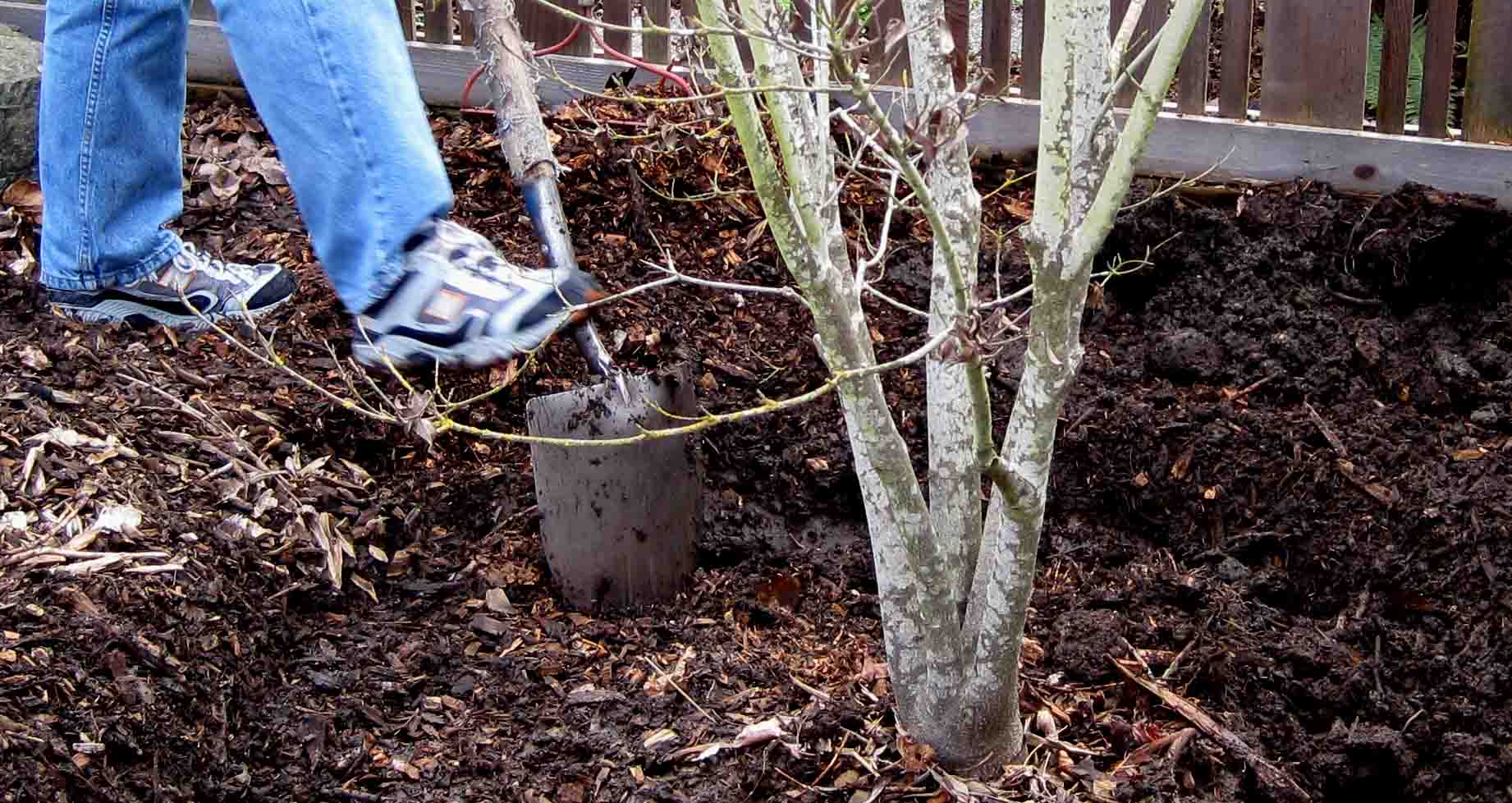
So in this area of our yard we have a perched water table: the water percolates through the topsoil, hits the clay, and spreads horizontally. When we had turf in place, it tended to keep the upper few inches relatively dry, which allowed the dogwood roots to survive. When we took out the turf and covered it with wood chips (to conserve water!), the soil became saturated nearly year round. We dug out the tree a few weeks ago, and this is all that remains of the root system; the rest of the major roots had rotted away:

We’ve replanted the tree in another area of the yard with much better drainage, and we’ll keep track of its establishment and leaf size. I think it will recover, as new roots will emerge from the main root mass.
(Paul, thanks for the kudos on the fence design! My husband built this, and he’ll be pleased to see your comment.)
Now I could have sworn I’d posted this puzzle before, but after searching through all the previous postings I can’t find it. Here it is.
I planted this Cornus kousa in 1999 (removing the burlap, clay, etc. prior to installing). We removed the turf (still attached to the $(%&$ plastic mesh) and planted the tree in the existing soil. The first photo was taken in 2004, and the second was taken in 2007:


Here are some specifics about what was done to the landscape during this period: we replaced all the turf with wood chips and put in the fence as shown. There was no impact on structural roots from either of these activities, and fine roots were affected minimally when we dug post holes for the fence. The turf was simply allowed to die back in the summer (hot summers do that here in Seattle) and then topdressed with wood chips. There were no chemicals applied, nor was there any soil disturbance.
It was about 2007 that we noticed the leaves were substantially smaller than previous years. The leaves are sparse and small, but they don’t become chlorotic or necrotic during the summer, nor does any part of the tree suffer more than any other. This phenomenon has continued until this year, when we finally dug it up and moved it elsewhere.
So here’s the question: why did this tree start swirling down the mortality spiral? As always, there may be many legitimate answers – but I’ll show you the actual reason on Monday!
Enjoy your weekend!
Some of my favorite plants are those that “do something” when little else is.
Do we really need more June-flowering perennials? No!
Well, yes. Never mind.
Edgeworthia chrysantha – “Paperbush” is the common name – is a deciduous suckering shrub , native to China. It usually maxes out around 4′ to 5′ tall and as wide. The large, matte bluish-green leaves resemble those of Magnolia virginia in shape and are also a bit silvery on the underside. But that’s not what we’re here for…
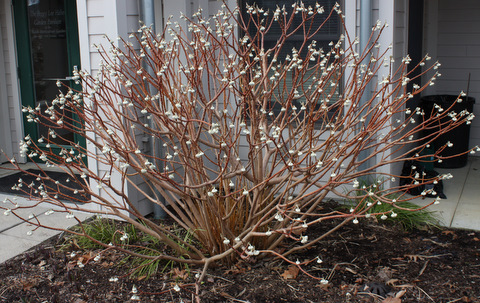
An oooh-aaahhh-worthy specimen at the Hahn Horticulture Garden, Blacksburg, VA.
Furry, silvery flower clusters dangle like earrings from the cinnamon stems throughout the winter, getting larger by the month.
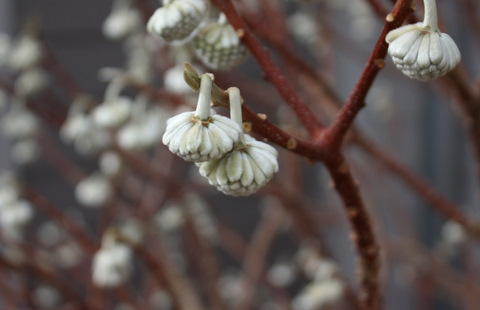
Then by late February or March, they open up, all golden and waxy, emitting a light, sweet fragrance on sun-warmed days.

Blooms at Pine Knot a few Springs ago…
Edgeworthia is ideal for the deciduous woodland environment. Hellebore specialists Dick and Judith Tyler of Pine Knot Farms (Clarksville, Virginia), situate theirs among drifts of spring bulbs and, of course, Hellebores. It’s a soul-stirring sight in March.
I believe the hardiness of Edgeworthia may be underestimated, especially if you go to a little effort to select the right microclimate. Dr. Dirr lists it as Zone 7 to 8(9). Having enjoyed them at the JC Raulston Arboretum during my doctoral work at NC State (Raleigh, North Carolina; Zone 7b), I found Edgeworthia was little-know here in the Blue Ridge (solid Zone 6, alledgedly 6a). We ordered some in for our Garden and Hort Club’s 2007 plant sale held in late April – despite my pleading and mark-downs, they didn’t generate much interest from shoppers as they were out of flower. We planted the left-overs in a fairly protected position on the North side of our garden pavilion, and they’re thriving. Snow was heaped up around them throughout January and February and we’ve gotten well into the single digits complete with howling winds a few times. Despite this rotten winter, they look better than ever, ready to burst into bloom any day now. Readers, please weigh in: Had any success with it in Zone 6? And why isn’t this fabulous thing more prevalent in the trade?
I just got back from a trip to Pullman where I guest lecture once a year for the Landscape Plant Management class. It’s also a chance to get some new photos for my Wall-O-Shame. Here’s my latest:
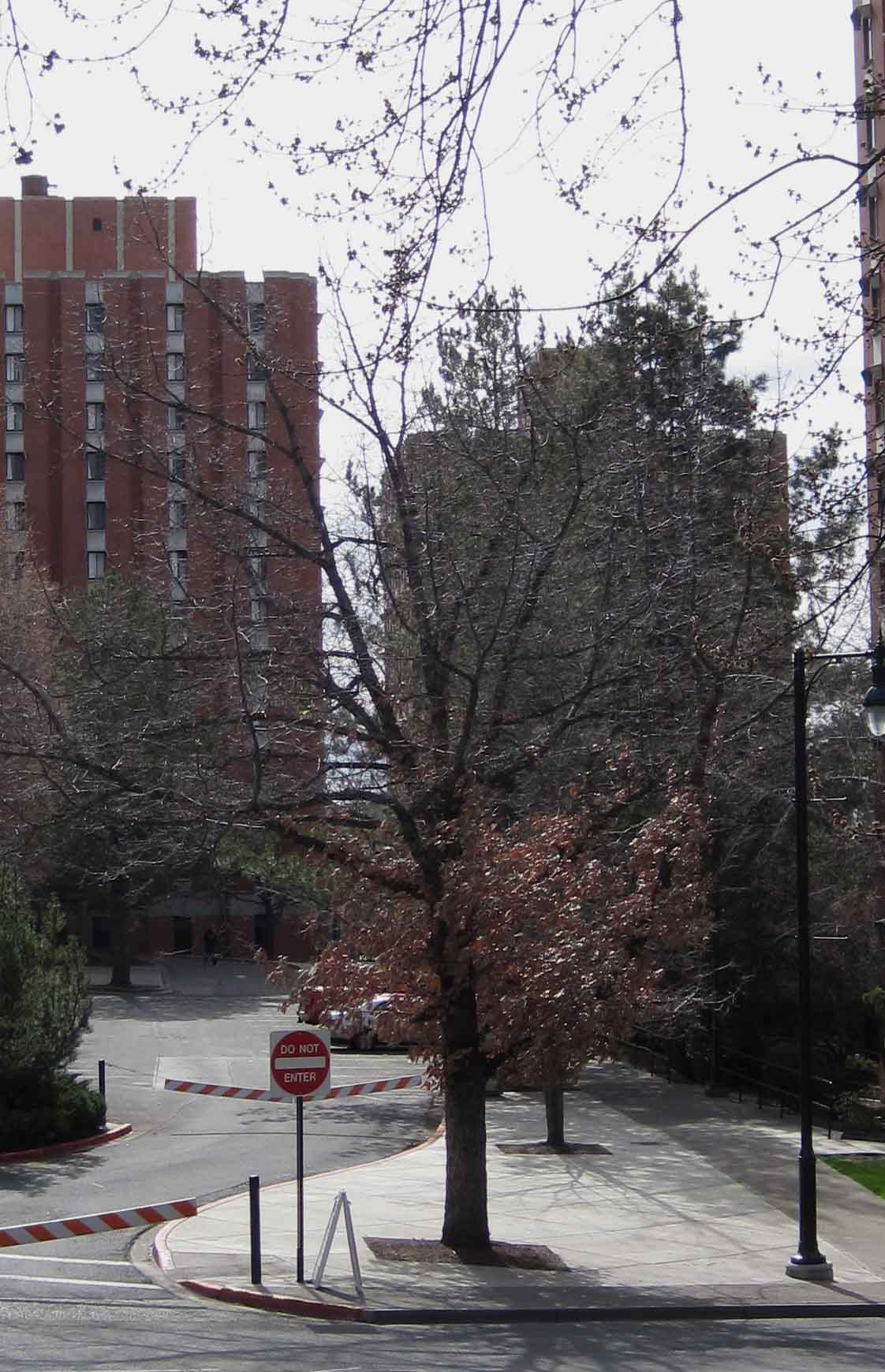
Pin oak (Quercus palustris) doesn’t drop its leaves in the winter – instead, they hang on until the following spring. So it’s really easy to see which part of this tree is alive (i.e., has last year’s leaves). It’s apparent that most of the crown has died, with only some lower scaffold branches remaining.
How did this happen? Take a look at how new that concrete is around the base of the tree (and how small the tree well is. This construction was done in 2004:

Note the complete lack of root zone protection. Not only has the majority of the tree’s fine roots been destroyed in preparation for pouring concrete, but only a very small space under the tree is “protected.” I guess the cup at the base represents the irrigation system. To top it off, this construction was done in August, when coincidentally I was there as well. It was blistering (as it usually is in the summer in eastern Washington), and the remaining leaves on this tree were wilted:
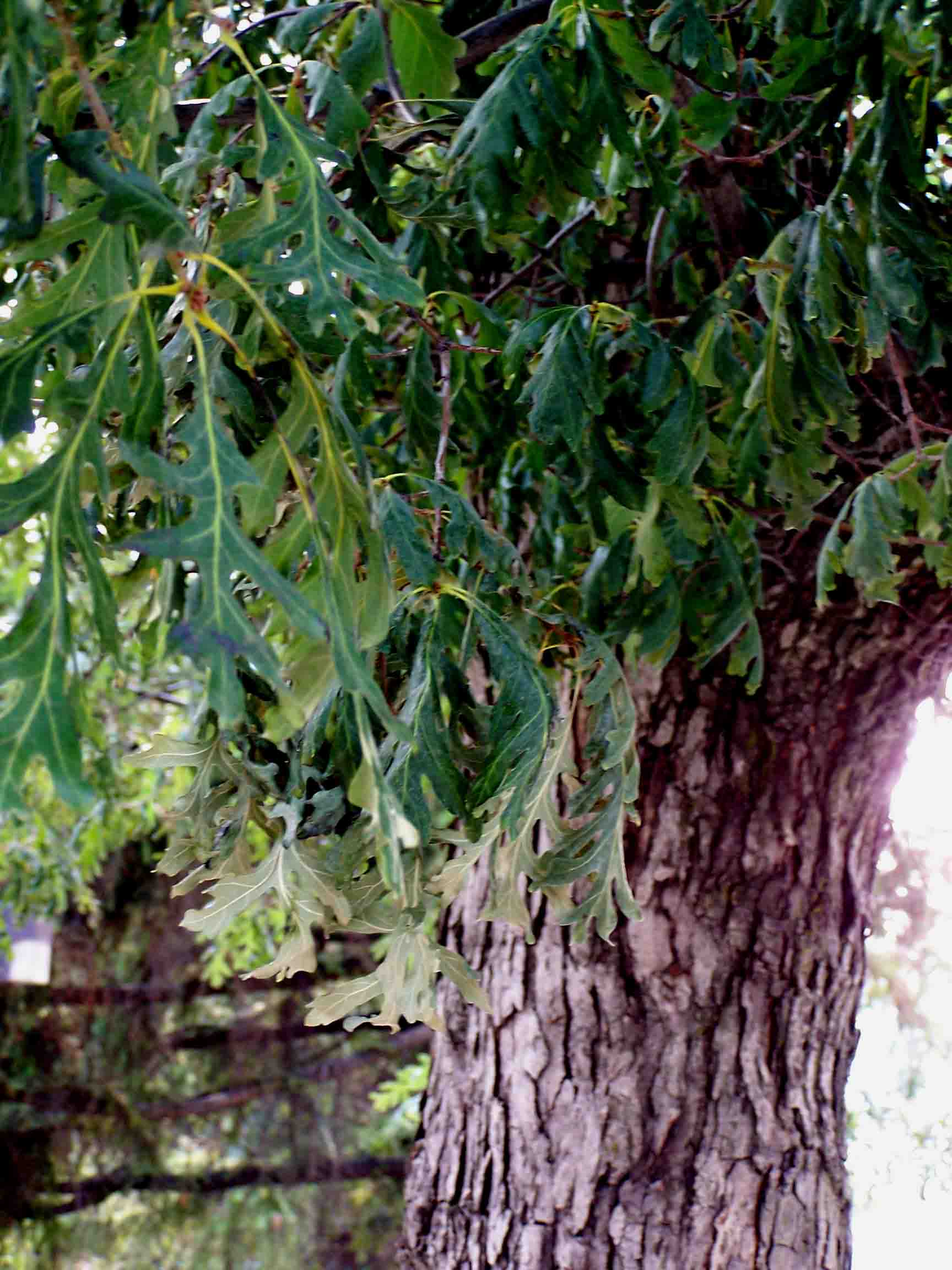
So why would anyone be surprised when, 6 years later, this tree looks like crap? And why doesn’t WSU insist on tree protection standards when construction bids are submitted?
Good sleuthing over the weekend! As John, Karen, Jimbo and Al suggested, there is something stuck on the side of this Norway maple (Acer platanoides, which is Latin for “maple that takes over the planet”). In fact, the reason that I, with my pathetic ID skills, know that it’s a Norway maple is because it’s a nursery tag stuck in the tree:
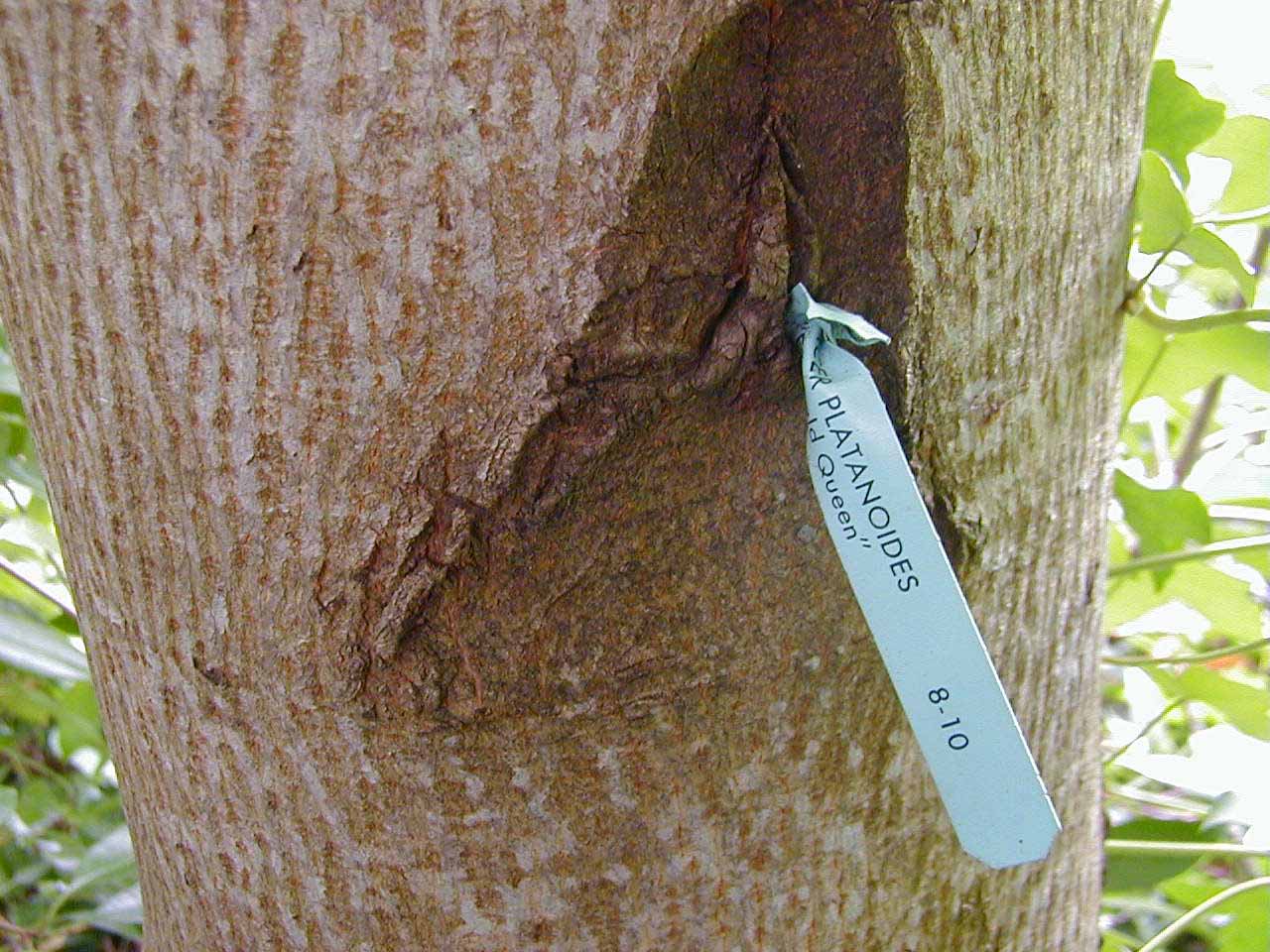
This type of injury really bugs me, because it’s entirely preventable. One of the cardinal rules of transplanting trees and shrubs is to remove all foreign material. And this is a perfect example of why. I don’t know the history of this tree, but this is was I think happened.
The tag was on a branch of the young tree; as the branch increased in girth, it became girdled by the plastic and died back. At the same time, the girth of the tree increased to encompass the base of the branch and the tag. The dying branch was either torn from or broke off the trunk, creating a tear in the bark and creating the horizontal scarring at the base of the wound.
If you’re hopeless with plant names (like I am), keep an electronic database of all the plants you’ve installed in your landscape, including the name, the date installed, and any notes, especially for failures (e.g. not cold hardy enough, invasive, too large, slug snack, etc.).